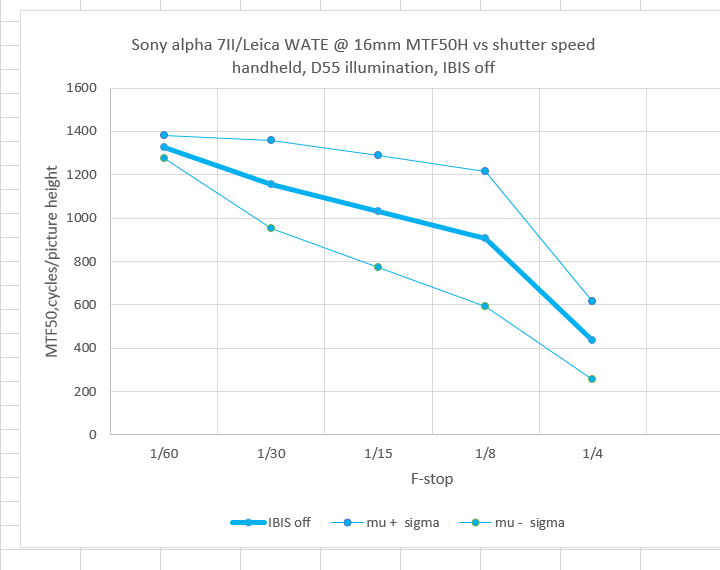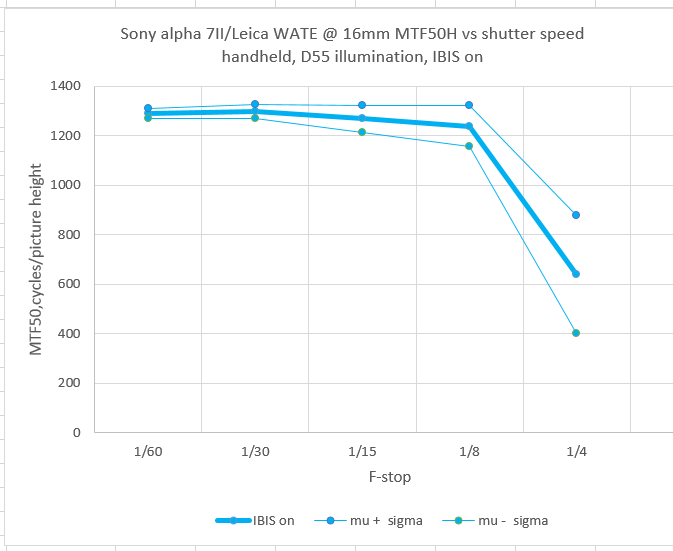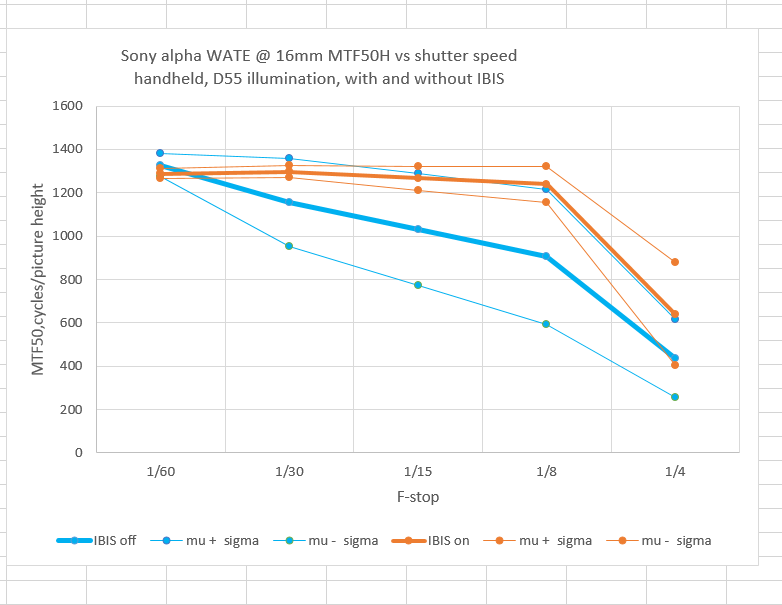A reader asked if I’d test the in-body image stabilization (IBIS) on the Sony alpha 7II with a really short lens, to add to the testing I’ve done previously with a 180mm Apo-Telyt and the Zony 55mm FE and the Leica 28mm f/2.8 Elmarit-R. I selected the Leica 16/18/21mm f/4 Tri-Elmar, aka the WATE. Sony calls IBIS SteadyShot.
I employed the following protocol:
- The camera: the Sony a7II.
- The lens: the Leica WATE, with a Novaflex M to E adapter, set to 16mm.
- The target: Imatest slanted edge with Siemans star for focusing.
- No filter.
- The lighting: a single Fotodiox LED-200WA-56 daylight balanced variable-output flood.
- ISO set to 400, f/8, to minimize the effect of manual focusing errors.
- Focusing manually at f/4, using the magnifier. The focus point as a Siemens star on the target.
- Drive set to single
- EFCS on
- Manual exposure mode.
- Hold the camera in the “Pete Souza” grip: left palm under base, left fingers bracing the underside of the front part of the lens, elbows against chest. With the WATE, you have to be careful to keep your fingertips out of the picture.
- Exposure protocol: LED light to full, shutter to 1/60 second, make 16 exposures, turn the light down a stop, make 16 exposures… until you get to 1/8 of a second.
- Develop in Lightroom 5.7.1 with standard settings.
- Crop, export as TIFFs, analyze for horizontal edge and vertical edge MTF50 in Imatest.
- Export the results to Excel, crunch the stats, and graph.
First, with IBIS off, looking at the horizontal edges:
Then with it on.
Finally, with both of the results sets on the same plot:
The heavy lines are the average,, or mean, values, for which the mathematical symbol is mu. The light lines are the mean plus and minus the standard deviation, or sigma, of the measurement set, and provide an estimate of repeatability.
It’s clear that IBIS helps a lot. As with the 28mm lens, 1/(half the focal length in mm) is eminently usable, and better than 1/(twice the focal length in mm) without IBIS.
However, at 1/4 second, IBIS isn’t much help at all. Is is possible that it runs out of travel at that shutter duration and my body motion. It’s also possible that translation, which it can’t correct for in lenses that don’t tell it the subject distance, becomes too big a factor at that shutter speed. The target was about three feet away from the camera.
It’s a small effect, but we saw it in the case of the 28mm lens, and we see it here: at high shutter speeds, IBIS might actually hurt a little. I wouldn’t worry about it.



NicoG says
Ahah, thanks a lot!
Interesting to see results degradation without IBIS (starting at 1/30 s).
More importantly, your results show that IBIS efficiency is the same whatever the focal lens! Also, it is impressive to see how MTF falls after 1/(twice the focal length in mm) with IBIS. This fall is not as clear for the standard (albeit it had 5 axis IBIS) and the tele lenses.
thanks
FAS says
Hmmm, it seems to be a “cap” at around 1/8s, isn’t it? Perhaps I was not totally wrong, then.
NicoG says
I was thinking the same: http://www.dpreview.com/forums/thread/3788046)
From my experience, I found it hard to have sharp shots with IBIS and an adapted MF lens (3 axis IBIS) below 1/10 s whatever the focal lens.
I’m currently playing with a Samyang 14 mm and 1/8 s is OK (not GOOD). At 1/6 s, it starts to be very hard to get a sharp shot and almost impossible at 1/4 s.